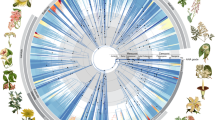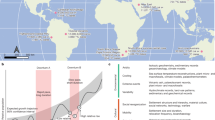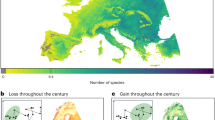Abstract
Climate change is predicted to alter global species diversity1, the distribution of human pathogens2 and ecosystem services3. Forecasting these changes and designing adequate management of future ecosystem services will require predictive models encompassing the most fundamental biotic responses. However, most present models omit important processes such as evolution and competition4,5. Here we develop a spatially explicit eco-evolutionary model of multi-species responses to climate change. We demonstrate that both dispersal and evolution differentially mediate extinction risks and biodiversity alterations through time and across climate gradients. Together, high genetic variance and low dispersal best minimized extinction risks. Surprisingly, high dispersal did not reduce extinctions, because the shifting ranges of some species hastened the decline of others. Evolutionary responses dominated during the later stages of climatic changes and in hot regions. No extinctions occurred without competition, which highlights the importance of including species interactions in global biodiversity models. Most notably, climate change created extinction and evolutionary debts, with changes in species richness and traits occurring long after climate stabilization. Therefore, even if we halt anthropogenic climate change today, transient eco-evolutionary dynamics would ensure centuries of additional alterations in global biodiversity.
This is a preview of subscription content, access via your institution
Access options
Subscribe to this journal
Receive 12 print issues and online access
$209.00 per year
only $17.42 per issue
Buy this article
- Purchase on Springer Link
- Instant access to full article PDF
Prices may be subject to local taxes which are calculated during checkout
 (guide, lower left panel) over time (y axis, ranging from 0 to 500 generations) and space (x axis) in communities with competition.
(guide, lower left panel) over time (y axis, ranging from 0 to 500 generations) and space (x axis) in communities with competition.


Similar content being viewed by others
References
Parmesan, C. & Yohe, G. A globally coherent fingerprint of climate change impacts across natural systems. Nature 421, 37–42 (2003).
Gregory, P. J, Johnson, S. N, Newton, A. C. & Ingram, J. S. I Integrating pests and pathogens into the climate change/food security debate. J. Exp. Bot. 60, 2827–2009 (2009).
Millenium Ecosystem Assessment: Ecosystems and Human Well-Being: Synthesis (Island Press, 2005).
Thomas, C. D. et al. Extinction risk from climate change. Nature 427, 145–148 (2004).
Urban, M. C., De Meester, L., Vellend, M., Stoks, R. & Vanoverbeke, J. A crucial step toward realism: Responses to climate change from an evolving metacommunity perspective. Evol. Appl. 5, 154–167 (2012).
Tylianakis, J. M., Didham, R. K., Bascompte, J. & Wardle, D. A. Global change and species interactions in terrestrial ecosystems. Ecol. Lett. 11, 1351–1363 (2008).
Franks, S. J., Sim, S. & Weis, A. E. Rapid evolution of flowering time by an annual plant in response to a climate fluctuation. Proc. Natl Acad. Sci. USA 104, 1278–1282 (2007).
Balanya, J., Oller, J. M., Huey, R. B., Gilchrist, G. W. & Serra, L. Global genetic change tracks global climate warming in Drosophila subobscura. Science 313, 1773–1775 (2006).
Skelly, D. K. et al. Evolutionary responses to climate change. Conserv. Biol. 21, 1353–1355 (2007).
Brooker, R. W. et al. Modelling species’ range shifts in a changing climate: The impacts of biotic interactions, dispersal distance and the rate of climate change. J. Theoret. Biol. 245, 59–65 (2007).
Münkemüller, T. & Bello, F. de From diversity indices to community assembly processes: A test with simulated data. Ecography 34, 1–13 (2011).
Gienapp, P., Teplitsky, C., Alho, J. S., Mills, J. A. & Merila, J. Climate change and evolution: Disentangling environmental and genetic responses. Mol. Ecol. 17, 167–178 (2008).
Pelletier, F., Garant, D. & Hendry, A. P. Eco-evolutionary dynamics. Phil. Trans. R. Soc. Lond. B. 364, 1483–1489 (2009).
De Mazancourt, C., Johnson, E. & Barraclough, T. G. Biodiversity inhibits species’ evolutionary responses to changing environments. Ecol. Lett. 11, 380–388 (2008).
Holt, R. D. Bringing the Hutchinsonian niche into the 21st century: Ecological and evolutionary perspectives. Proc. Natl Acad. Sci. USA 106, 19659–19665 (2009).
Lenormand, G. Gene flow and the limits to natural selection. Trends Ecol. Evol. 17, 183–189 (2002).
Case, T. J. & Taper, M. L. Interspecific competition, environmental gradients, gene flow, and the coevolution of species’ borders. Am. Nature 155, 583–605 (2000).
Ackerly, D. D. Community assembly, niche conservatims, and adaptive evolution in changing environments. Int. J. Plant Sci. 164, S165–S184 (2003).
Leibold, M. A., Holt, R. D. & Holyoak, M. in Metacommunities: Spatial Dynamics and Ecological Communities (eds Holyoak, M., Leibold, M. A. & Holt, R.) (Univ. Chicago Press, 2005).
Collins, S. & Gardner, A. Integrating physiological, ecological and evolutionary change: A Price equation approach. Ecol. Lett. 12, 744–757 (2009).
Kubisch, A. et al. On the elasticity of range limits during periods of expansion. Ecology 91, 3094–3099 (2010).
Burton, O. J. et al. Trade-offs and the evolution of life-histories during range expansion. Ecol. Lett. 13, 1210–1220 (2010).
Mousseau, T. A. & Roff, D. A. Natural selection and the heritability of fitness components. Heredity 59, 181–197 (1987).
Hoffman, A. A. & Sgrò, C. M. Climate change and evolutionary adaptation. Nature 470, 479–485 (2011).
Chen, I. et al. Rapid range shifts of species associated with high levels of climate warming. Science 333, 1024–1026 (2011).
Willis, K. J. & MacDonald, G. M. Long-term ecological records and their relevance to climate change predictions for a warmer world. Annu. Rev. Ecol. Evol. Syst. 42, 267–287 (2011).
Bell, G. & Gonzalez, A. Adaptation and evolutionary rescue in metapopulations experiencing environmental deterioration. Science 332, 1327–1330 (2011).
Brockhurst, M. A. et al. Niche occupation limits adaptive radiation in experimental microcosms. PLoS ONE 2, e193 (2007).
Lau, J. A. et al. Species interactions in a changing environment: Elevated CO2 alters the ecological and potential evolutionary consequences of competition. Evol. Ecol. Res. 12, 435–455 (2010).
Acknowledgements
This work was conducted as part of the Evolution in Meta-Communities Working Group supported by the National Center for Ecological Analysis and Synthesis, a centre financially supported by the NSF (grant EF-0553768), the University of California, Santa Barbara and the State of California. Additional support was also provided for M. Urban, the NCEAS postdoctoral associate in the group. J.N. was supported by the Swedish Research Council and the Strategic Research Program EkoKlim at Stockholm University. M.C.U. was supported by NSF award DEB-1119877 and a J. F. McDonnell foundation grant. M.V. was supported by the Natural Sciences and Engineering Research Council, Canada. N.L. received financial support from Université Pierre & Marie Curie and from CNRS. C.A.K. was supported by grants from the J. S. McDonnell Foundation and NSF awards DEB-0845825, OCE-0928819 and DEB-1136710. C. de Mazancourt provided insights for the partitioning of the change in mean trait. This is contribution 1700 of the Kellogg Biological Station.
Author information
Authors and Affiliations
Contributions
All authors conceived the problem and formulated the model. C.A.K. and J.N. coded the model. J.N. ran the simulations. All authors contributed to interpretation of results and writing the paper.
Corresponding author
Ethics declarations
Competing interests
The authors declare no competing financial interests.
Supplementary information
Supplementary Information
Supplementary Information 1 (PDF 1200 kb)
Supplementary Information
Supplementary Information 2 (PDF 241 kb)
Rights and permissions
About this article
Cite this article
Norberg, J., Urban, M., Vellend, M. et al. Eco-evolutionary responses of biodiversity to climate change. Nature Clim Change 2, 747–751 (2012). https://doi.org/10.1038/nclimate1588
Received:
Accepted:
Published:
Issue Date:
DOI: https://doi.org/10.1038/nclimate1588
This article is cited by
-
Transnational conservation to anticipate future plant shifts in Europe
Nature Ecology & Evolution (2024)
-
Relationships of temperature and biodiversity with stability of natural aquatic food webs
Nature Communications (2023)
-
Individual-Based Models for Incorporating Landscape Processes in the Conservation and Management of Aquatic Systems
Current Landscape Ecology Reports (2023)
-
Eco-evolutionary dynamics in two-species mutualistic systems: one-sided population decline triggers joint interaction disinvestment
Evolutionary Ecology (2023)
-
Eco-evolutionary responses of the microbial loop to surface ocean warming and consequences for primary production
The ISME Journal (2022)



